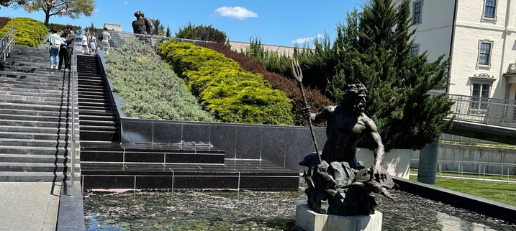
THR's opinion
New Destination Visitor Strategies: What Are DMO’s Doing Post-Covid?
As destinations further open into a post-Covid world, many are finding that their previous tourism marketing strategies are no longer relevant or at minimum, outdated.
Destination Marketing Organizations, or DMOs, are the local or regional groups tasked with the creation and execution of marketing plans to bring visitors to a place. As Covid wreaked havoc on the tourism sector, most DMOs were forced to reevaluate their visitor-attraction strategies, and some to reinvent themselves entirely.
Case Study: Richmond, Virginia
THR spoke with the DMO of the municipality of Richmond, Virginia, a mid-size American region of approximately 1.3 million metro-area inhabitants, as representative of the challenges that a large portion of cities experienced during Covid.
Richmond, as the capital of the state of Virginia on the United States’ Atlantic coast, has a robust social, cultural, and economic ecosystem, with lots on offer for visitors, though is not as well-known as larger peers like nearby Washington, D.C., for example. Richmond boasts a world-class art museum, the Virginia Museum of Fine Arts, an eccentric, vibrant downtown area – Carytown – the James River running right through the center of the city that residents often use for rafting, swimming, hiking, and to escape the city’s summer heat, the Fan architectural district, and new, fast-growing expansions to the traditional city limits with vibrant neighborhoods such as Scott’s Addition.
Pre-Covid Strategy
THR spoke with J.C. Poma, Vice President of Community Relations for Richmond Region Tourism. Poma pointed out that even prior to Covid, Richmond was a serious regional player with an established 10-year plan for tourism and multiple programs activating specific visitor segments such as sports and business travel.
Other initiatives such as BLKRVA, centered on the black community as a “true celebration of black culture in the Richmond region,” and OUTRVA, directed towards LGBTQ tourism, served a dual purpose – to build a sense of community and inclusiveness for residents who identified or were allied with those groups, while also outwardly broadcasting those messages to “help tell the story of a welcome and inclusive Richmond, nationally,” Poma commented.
The double intention of the strategy, to be good for residents as well as visitors, was codified through “our passion to create unique, authentic experiences not just for those who visit but for our local constituents as well,” said Poma.
Engaging Local Residents as Brand Ambassadors
That 10-year strategic plan, of course, faced major challenges once Covid hit. Though initially the day-to-day of the DMO stayed its course – in the early stages of the pandemic it was only supposed to take two weeks to “flatten the curve” – it soon became apparent a shift was needed.
When reality set in that the pandemic was going to last, Richmond Region Tourism augmented a number of initiatives to stay active and engaged. The DMO quickly realized that focusing on the role local residents could play in tourism was key to recovery.
Poma and team began accelerating a program to convert local residents into the principal ambassadors for tourism. The DMO developed the “I Am Tourism” program to train and offer resources to residents, highlighting the tourism opportunities the Richmond area had to offer, even pivoting to a paid local campaign to promote awareness during Covid.
With informational videos, workshops, and other communication channels, I Am Tourism gave ambassadors the chance to serve as the first-line faces of the region, expanding the reach of the DMO’s message through the most reliable channel for promoting a product: friends and family.
The I Am Tourism program had another positive ancillary effect: the DMO realized that it was an opportunity to educate on the growth and new assets the region had in its own back yard, many of which were outdoor and adventure related, for example Class 4 rapids in the city’s James River.
Another initiative was “Take Out RVA” which encouraged residents to support local restaurants impacted by the pandemic by ordering take-out food. Consequently, many Richmond residents explored dining options they otherwise may not have, a boost to the gastronomic ecosystem of the city.
As Poma notes, “Covid 19 allowed us to think through the mind of our constituent,” understanding and capitalizing on the opportunities the city offered.
Sports for the Win
Poma also noted that “sports tourism has really led our recovery.” From July 2021 to April 2022 the region had record occupancy levels, much of it related to sports tourism and leisure travel. Currently there’s a plan for a new indoor sports center, an additional arena, and the River City Sportsplex – a 16-field soccer complex – among other major sports-related initiatives. The investment in sports tourism certainly helped the city bear the brunt of the tourist downturn.
Poma commented that “sports gives every destination in the country the opportunity to compete.” Much of sports tourism is also composed of day trips, giving a needed boost to direct services like restaurants and indirect services like gas stations.
So What’s Next for Richmond Tourism?
Poma notes that while the recovery has been uneven – as with most destinations - there are signs of a definite rebound, and for Richmond “we’re already seeing record occupancy levels in the region, and this despite record gas prices.”
For Richmond Region Tourism, the main focus is to continue to stay active and engaged with both local and visiting stakeholders. “Covid debilitated our sector but really forced us to learn from our constituents and each other,” said Poma.
Engaging with local residents is crucial: every single person in the community can play a vital role in supporting tourism and becoming a tourism ambassador. “Inviting local constituents to partner with us by promoting Richmond and inviting their friends and family has been key.”
“We used to talk a lot about ´heads and beds´ but it’s so much more clear now the benefit of working with our constituents,” noted Poma.
Guest article by THR Senior Director, Marketing, Benjamin Rhatigan